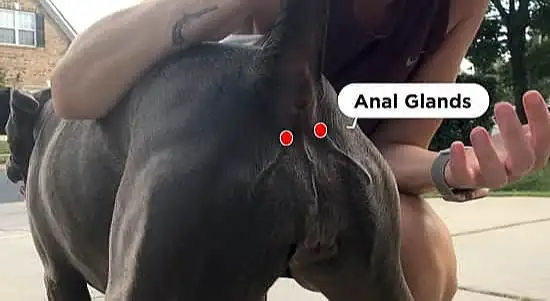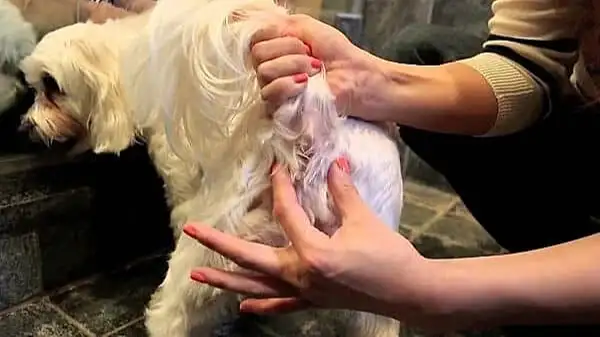Perhaps, you have read a lot of information about dog anal glands or anal sac disease in dogs. But not all of it is true.
Unfortunately, one such misconception is that we must express dog anal glands to relieve pressure or for medical reasons.
On the other hand, many people ask how to express dog anal glands. Generally, the truth is that it’s unnecessary and inadvisable to do so, as pressing on the gland could lead to an abscess.
In this article, I will discuss the following topics:
- What are anal sacs disease in dogs, and how its works?
- What problem do anal sacs cause in dogs?
- How to know that your dog has anal sac disease?
- Symptoms of dog anal glands disease
- How to prevent dog anal sacs?
- Best dog food for anal gland problems
What are the anal sacs?
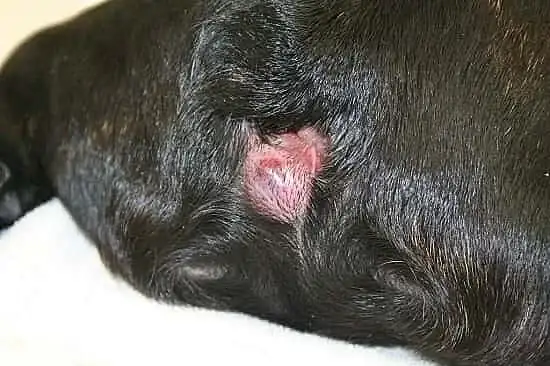
MORE: How to Find the Best Dog Groomer near you?
Anal sac disease, also known as perianal disease, is a widespread problem in dogs. The anal sacs are two glands that fill up with a gooey substance called porphyrin.
However, it can cause a stench and irritation around the anus. You can find the anal sacs on either side of the rectum between the last two vertebrae of the tail.
The function of these glands is to provide lubrication for fecal matter while it is being expelled from the body. In dogs, anal sac disease can occur when the glands become infected or inflamed.
Unfortunately, pus and other fluids can gather in the sacs when this happens. Therefore, it leads to a lot of discomfort for the dog.
Read More: Why Does My Dog Smell Like Fish?
How anal sacs works?
The anal sacs location is on either side of the rectum, just inside the animal’s anus. Generally, these sacs contain a thick, brown fluid. Also, it releases oily fluid whenever the dog defecates.
The fluid helps to lubricate feces. So they can pass through the rectum and out of the body. Dogs use this lubrication to help avoid developing hairballs in their digestive tract.
Does anal sac in dogs cause a problem?
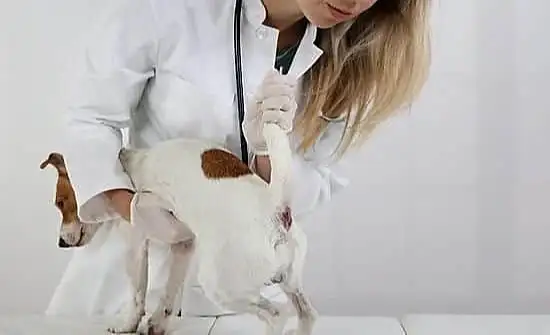
Anal sac disease in dogs is a controversial topic. It does not have a clear answer as to whether or not it is truly a health issue.
Some veterinarians would say that the sacs are part of the dog’s anatomy and do not represent any medical concern. But they can be impacted by other issues within the dog’s body.
For example, suppose your dog has an underlying gastrointestinal disorder (such as gastritis). In that case, the anus may inflame and develop small bumps on its surface.
Also, these bumps will have little bits of food trapped inside them. If left untreated, this condition can lead to severe infections of the dog anal glands and cause anal pain for the pet.
This is why most vets recommend that owners keep their pets from eating certain foods until anal sac problems resolve.
How will I know if my dog has anal sac problems?
Anal sac diseases can occur in dogs, and it is essential to know the signs of the condition. The anal sacs are two small glands about 3 inches (8 centimeters) long on either side of the anus.
They produce an odiferous liquid that masks other scents near the dog’s rear end. In addition, an infection in this area can have to swell around the anus.
Therefore, it can cause difficulty walking or sitting down. Perhaps, you don’t find any dog grooming near you. As a result, it can develop an anal sac disease in dogs without regular grooming.
Usually, the anal sacs are located near the rectum and release fluid when the dog is excited or frightened. MORE: What is a Droopy Dog, and why is it called so?
Symptoms of dog anal glands disease
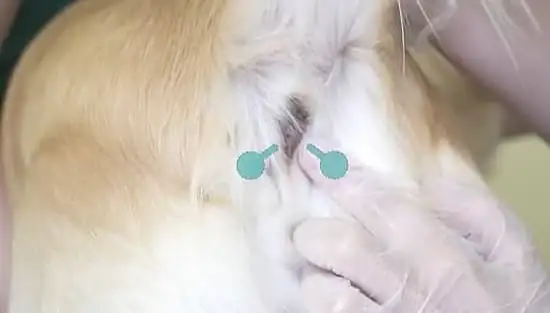
Dog Anal Sac Disease symptoms can be challenging to spot. But the tell-tale sign is an unpleasant odor from your dog’s rear area.
Other symptoms include:
- Scooting their bottom across the floor.
- Licking themselves excessively in that area.
- Possible bleeding.
- Bad smell from your dog.
- Biting of the affected area.
- Pain when in bowel movement.
- Brown stains on the floor and his bed.
- The anal site becomes swelling and redness.
Some dogs may experience pain or discomfort during elimination or have trouble controlling their bowels or bladder. This condition can lead to severe infection and other health risks.
Suppose you suspect anal sac disease in a home dog. In that case, it’s essential to see his doctor as soon as possible for treatment options and prevention precautions.
A veterinarian will examine your pet thoroughly and give him a thorough examination to rule out any underlying medical problems.
How do I treat dog anal glands?
In most cases, removing affected glands is enough to stop the problem from recurring. In some cases, however, the abscesses are large and painful. Also, these cases often require surgery to remove them altogether.
Why do dogs need anal glands?
As I have noted before, anal glands are natural protection for dogs. They produce a lubricant for the anus and surrounding area.
However, if the glands become infected or inflamed, they can cause unpleasant symptoms for your dog. These include: anal sac disease in dogs often suffer from excessive itching and discomfort.
The glands also give off a foul-smelling liquid that can irritate the skin and cause secondary infections. In some cases, the problem can be so severe. It affects your dog’s quality of life.
How to Express Dog Anal glands?
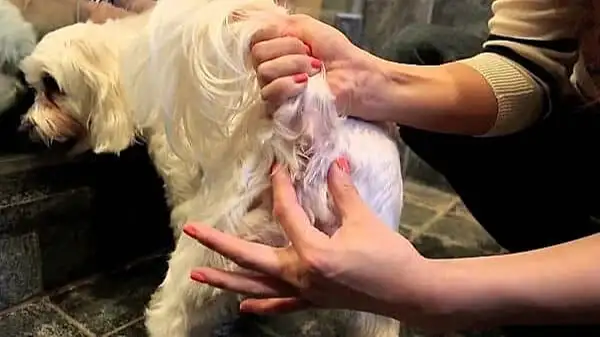
Perhaps, you observe dog anal glands smell with a brown stain on the floor. If so, it’s time to express dog anal glands and clear them.
Surprisingly, learning how to express dog anal glands is not that difficult. With the proper tools, you can do it yourself in only a few easy steps.
However, this article will help you expressing dog anal glands. It will explain what anal glands are and how to express them.
Also, we will tell you why dogs need anal glands and how to prevent them from developing anal sac problems.
Let’s find out how to squeeze anal glands on a dog. But, first, here is a brief guide on how to clean dog anal glands:
- Wear gloves made of latex and keep an extra warm cloth in your bag.
- Locate the anal glands between 4 and 8 o’clock while studying the anus.
- Apply gentle but firm pressure to the glands beneath the skin. Move toward the upward direction and then back towards the anus.
- Then you should place the cloth over the anus to keep the odorous fluid from spreading everywhere.
- Finally, wipe the dog clean, and offer them a treat. Also, it will lower the dog anal glands smell.
Keep in mind that dog anal glands cleaning is not easy. Above, I just mention some steps I follow when cleaning dog anal glands. But always I suggest consulting with a professional.
When a dog has more than one infected gland, veterinarians may recommend draining or surgically removing all infected glands rather than just individual ones.
The vet may also prescribe antibiotics for at least several weeks after the procedure.
Preventing Anal Sac Disease in Dog
Most people think that dog anal sacs only produce a scent when full of feces. However, this is not true, as dogs can also have a buildup of secretions from glands around the anus which will cause an infection if not cleaned out.
Suppose you notice the dog anal glands problem. In that case, it is best to get him checked by the veterinarian because most forms of this condition go untreated for months.
In addition, he could be developing complications such as blood in his stool or urinary tract infections due to undiagnosed problems in the bladder.
Also, some breeds seem more likely than others to take on anal sac issues. For example, German Shepherds, Labrador Retrievers, Golden Retrievers, and Chows tend to develop more frequent cases of anal sac problems.
Best Dog Food For Anal Gland Problems
Some dogs exhibit anal gland problems, leading to scooting and excessive licking. The best dog food for anal gland problems is a dry kibble with a medium-low fat content.
Both wet and dry foods contain essential nutrients for dogs. Still, wet food contains water and carbohydrates.
It helps with hydration and staves the urge to eat the dog’s feces. Dry food does not have these benefits and may cause overeating.
Suppose your dog has an underlying problem (such as fleas or another skin disease). In that case, giving him some additional nutrition might be beneficial to supplement his diet.
What Should I Do With My Dog Impacted Anal Gland?
Dogs have anal glands that help them mark their territory. But sometimes, these glands can become impacted and need to be expressed.
Suppose you see your dog with an impacted anal gland. In that case, you must express dog anal gland in a proper way.
You can do it at home or by a veterinarian.
However, you will need some supplies if you express your dog’s anal gland at home.
You will need a lubricant, such as petroleum jelly or mineral oil, and a small rubber bulb syringe. You can purchase a bulb syringe at most drug stores.
To express your dog’s anal gland, follow these steps:
- Lubricate the end of the syringe with the lubricant.
- Gently insert the lubricated end of the syringe into the dog’s anus.
- Squeeze the bulb on the syringe. It will force the liquid out of the dog’s anal gland.
- Repeat until you have removed all of the liquid from your dog’s anal gland.
Dog Anal Glands: How To Express Them At Home
Conclusion:
Dog anal glands disease is prevalent but often overlooked by pet owners. The anal sacs are located at the opening of the anus and produce an oily fluid with a foul odor.
If these sacs become impacted, they can swell and cause your dog to scoot across the floor or exhibit other behaviors that signify discomfort.
This condition usually resolves itself with time and proper treatment if caught early enough. However, it can be pretty painful for dogs, and adequate treatment should prevent complications such as infection.
Frequently Asked Question:
Q. What is the treatment for anal glands disease in dogs?
A. Infections, cancer, or tumors can cause anal sac disease in dogs. However, it is essential to note that this disease is not contagious.
The signs of anal sac disease are foul-smelling discharge around the anus and inflammatory response.
Suppose your dog shows any signs of discomfort around the rectum. In that case, it may indicate anal sac disease, and the pet needs a vet. Treatment options for anal sac disease include antibiotics to clear up any infection or neoplastic processes.
Q. What causes dog anal glands problems?
A. The anal sacs are a pair of glands located near the anus in dogs. When these glands become inflamed or infected, it can cause a lot of discomfort for your pet.
The problem may be due to a high-fat diet, low water intake, or poor grooming habits. The inflammation can lead to infection and pus accumulation. In other cases, it could be due to other problems such as tumors or skin infections.
Q. Is anal sac disease in dogs curable?
A. Anal sac disease is a painful and uncomfortable condition that affects dogs of all breeds. The disease can lead to complications such as anal gland inflammation or abscess, requiring veterinary treatment. Proper treatment and antibiotics can cure anal sac disease in dogs.
Q. How to express dog anal glands?
A. Anal sac disease, also known as perianal disease, is a very common problem in dogs. The anal sacs are two glands that fill up with a gooey substance called porphyrin.
It can cause a stench and irritation around the anus. Generally, you can see the anal sac on either side of the rectum between the last two vertebrae of the tail.

Sonali had a collection of 12 dogs, each with a unique story. She loved nothing more than writing about their personalities and quirks.

